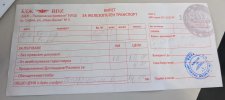With the UK gradually switching from our nice traditional CCST mag stripe card stock to orange paper roll stock and now even white paper roll stock i thought it would be interesting to discuss ticket stocks currently used in other countries.
Are there any other countries that have switched from higher quality paper card ticketing to cheap paper roll tickets as i am curious if this downgrade is being done elsewhere?
Also are there any other countries (other than the UK and Ireland) that still use CCST tickets (bank card sized tickets printed on thicker card paper) or use mag stripe tickets or even use CCST mag stripe just like us?
I know in Paris they used mag stripe tickets but they are much smaller. They are about the size of our old Edmondson tickets. Warsaw also used the same tickets that Paris uses. There might be a few other countries with mag stripes but i can not think of any off the top of my head.
Netherlands use CCST stock but it is not mag stripe. Instead it has a tiny thin smartcard chip in it. Basically a disposable smartcard. think the Glasgow Subway use the same stock.
Eurostar still use airplane tickets. These are those massive tickets printed on thicker card stock. I think quite a few Mainland European operators use those too. We used to have them in the UK for advance tickets but they were scrapped in the early or mid 2000s.
Are there any other countries that have switched from higher quality paper card ticketing to cheap paper roll tickets as i am curious if this downgrade is being done elsewhere?
Also are there any other countries (other than the UK and Ireland) that still use CCST tickets (bank card sized tickets printed on thicker card paper) or use mag stripe tickets or even use CCST mag stripe just like us?
I know in Paris they used mag stripe tickets but they are much smaller. They are about the size of our old Edmondson tickets. Warsaw also used the same tickets that Paris uses. There might be a few other countries with mag stripes but i can not think of any off the top of my head.
Netherlands use CCST stock but it is not mag stripe. Instead it has a tiny thin smartcard chip in it. Basically a disposable smartcard. think the Glasgow Subway use the same stock.
Eurostar still use airplane tickets. These are those massive tickets printed on thicker card stock. I think quite a few Mainland European operators use those too. We used to have them in the UK for advance tickets but they were scrapped in the early or mid 2000s.




